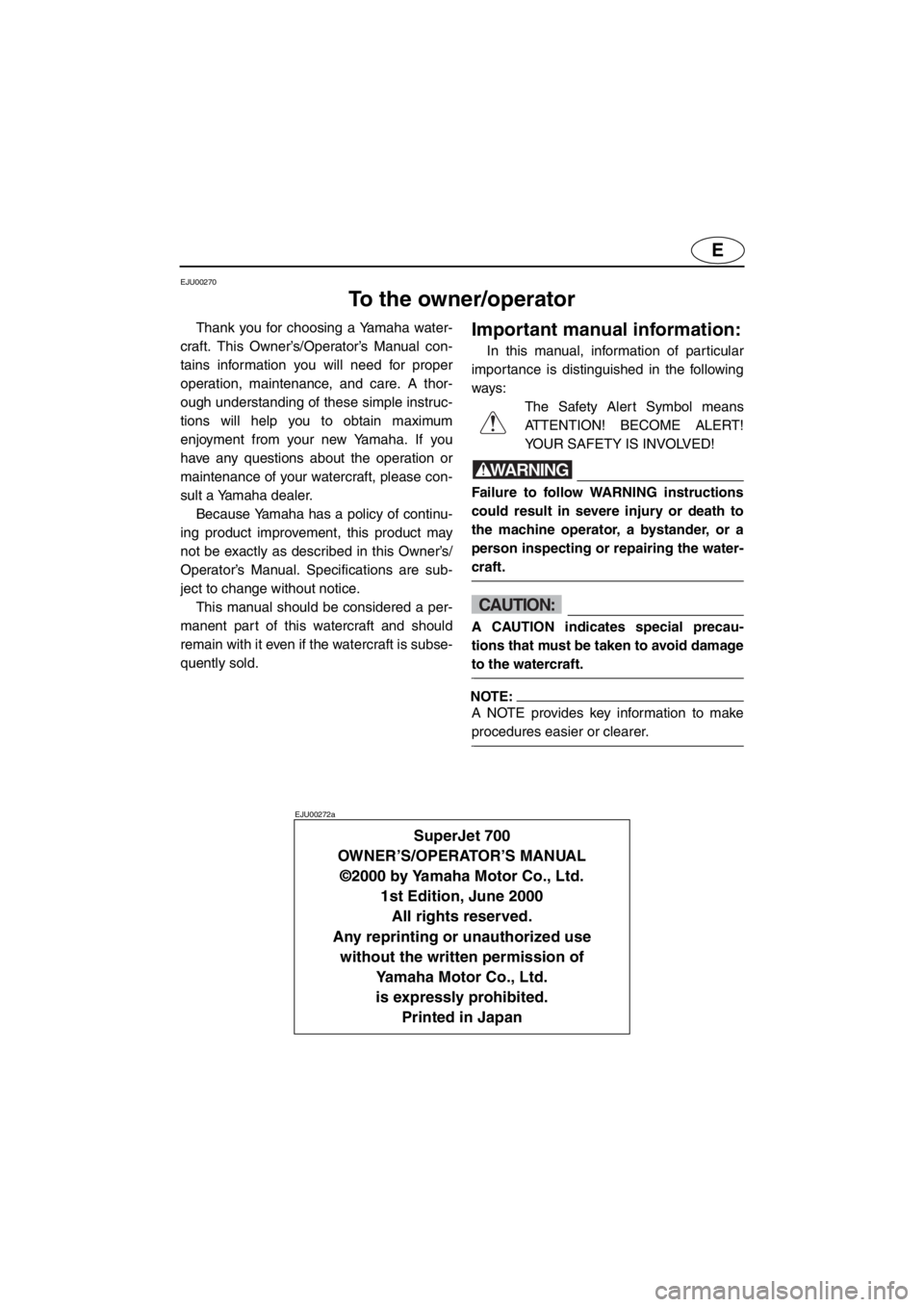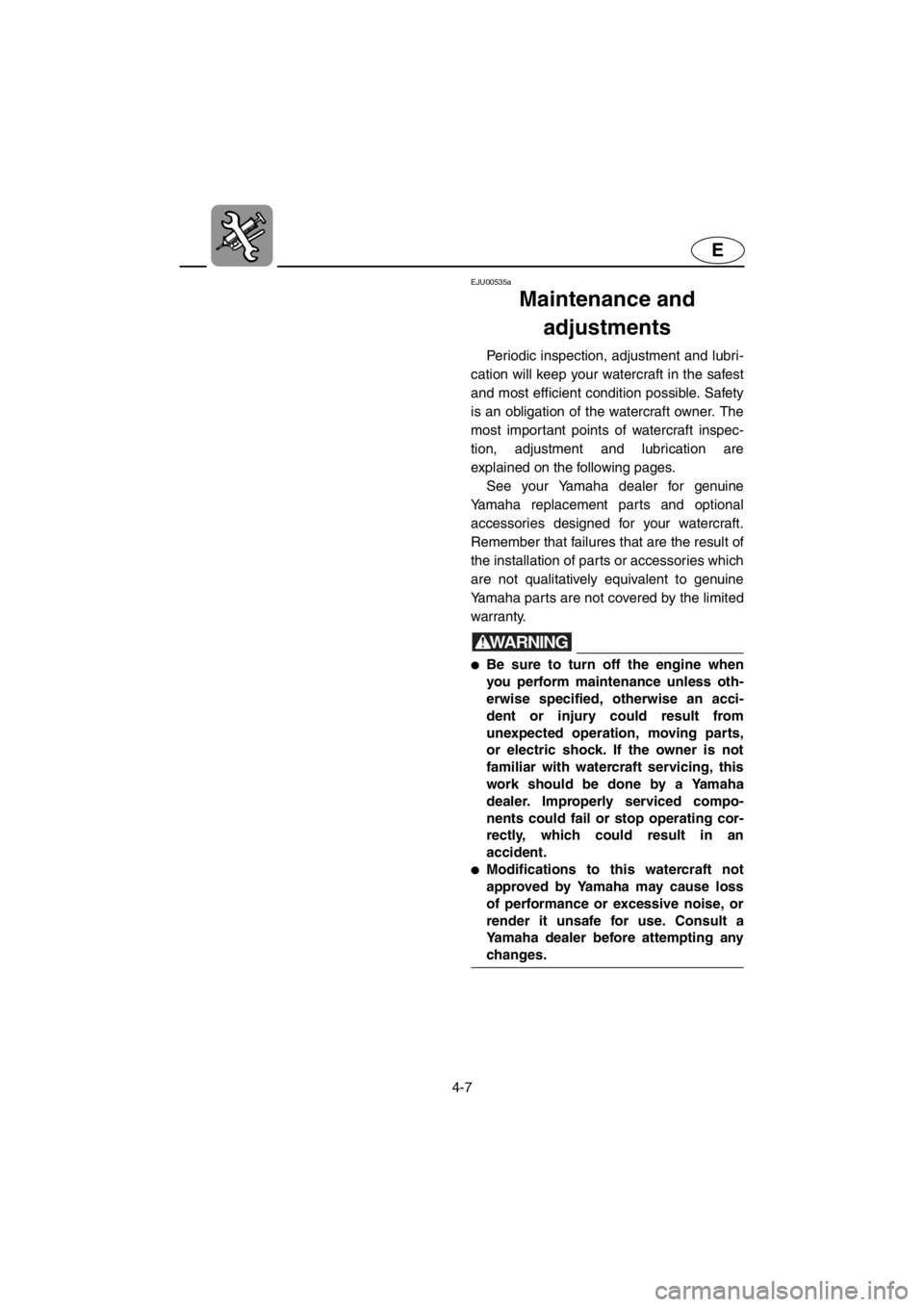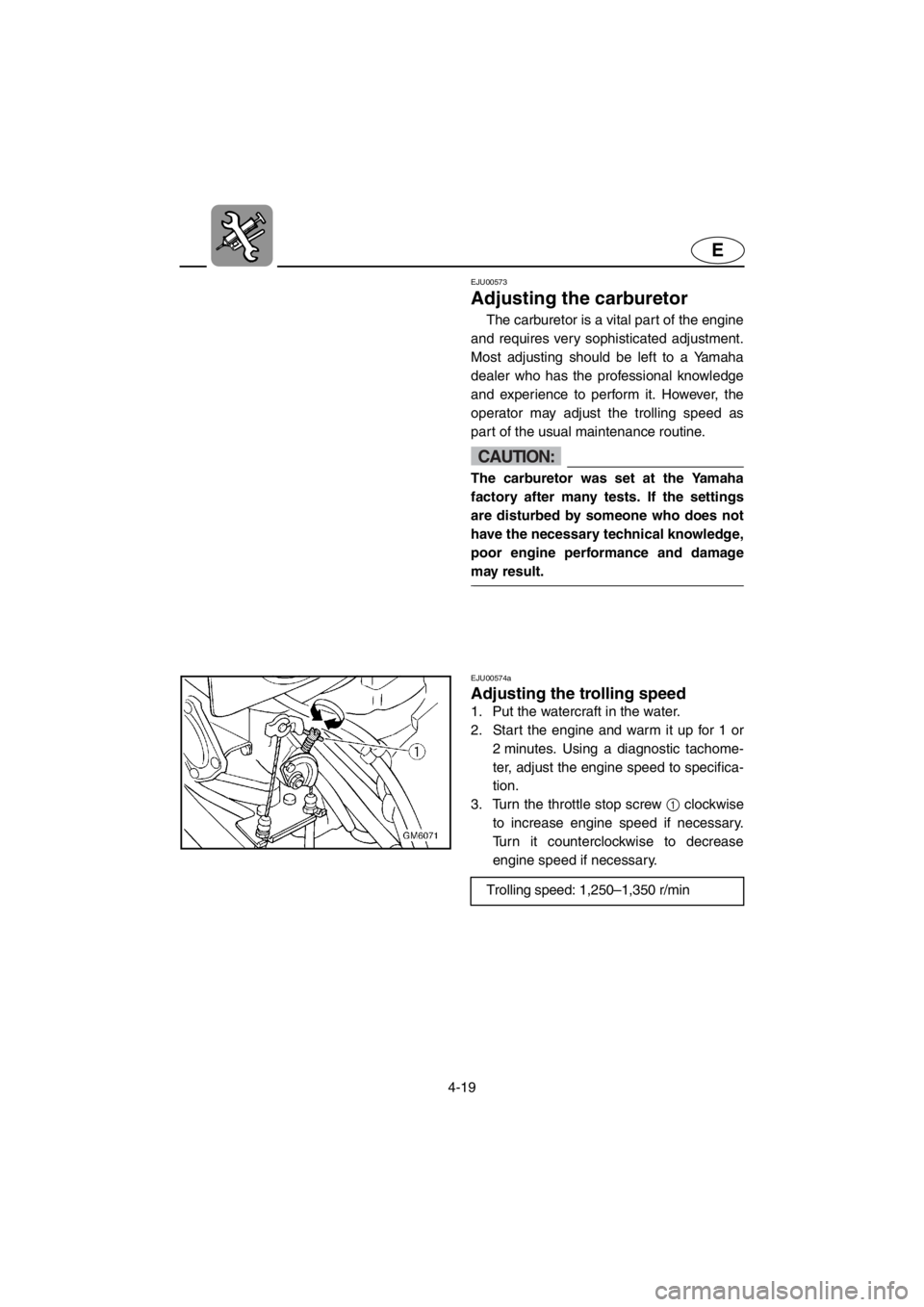maintenance YAMAHA SUPERJET 2001 Owners Manual
[x] Cancel search | Manufacturer: YAMAHA, Model Year: 2001, Model line: SUPERJET, Model: YAMAHA SUPERJET 2001Pages: 107, PDF Size: 6.2 MB
Page 3 of 107

E
EJU00270
To the owner/operator
Thank you for choosing a Yamaha water-
craft. This Owner’s/Operator’s Manual con-
tains information you will need for proper
operation, maintenance, and care. A thor-
ough understanding of these simple instruc-
tions will help you to obtain maximum
enjoyment from your new Yamaha. If you
have any questions about the operation or
maintenance of your watercraft, please con-
sult a Yamaha dealer.
Because Yamaha has a policy of continu-
ing product improvement, this product may
not be exactly as described in this Owner’s/
Operator’s Manual. Specifications are sub-
ject to change without notice.
This manual should be considered a per-
manent part of this watercraft and should
remain with it even if the watercraft is subse-
quently sold. Important manual information:
In this manual, information of particular
importance is distinguished in the following
ways:
The Safety Alert Symbol means
ATTENTION! BECOME ALERT!
YOUR SAFETY IS INVOLVED!
WARNING@Failure to follow WARNING instructions
could result in severe injury or death to
the machine operator, a bystander, or a
person inspecting or repairing the water-
craft.
@
CAUTION:@A CAUTION indicates special precau-
tions that must be taken to avoid damage
to the watercraft.
@
NOTE:@A NOTE provides key information to make
procedures easier or clearer.
@
EJU00272a
SuperJet 700
OWNER’S/OPERATOR’S MANUAL
©2000 by Yamaha Motor Co., Ltd.
1st Edition, June 2000
All rights reserved.
Any reprinting or unauthorized use
without the written permission of
Yamaha Motor Co., Ltd.
is expressly prohibited.
Printed in Japan
E_GM6_info.fm Page 1 Tuesday, July 11, 2000 10:48 AM
Page 5 of 107

EEJU00273
CONTENTS
READ THIS OWNER’S/OPERATOR’S MANUAL CAREFULLY BEFORE
OPERATING YOUR WATERCRAFT.
GENERAL AND SAFETY
INFORMATION
1
FEATURES AND FUNCTIONS2
OPERATION 3
MAINTENANCE AND CARE4
TROUBLESHOOTING AND
EMERGENCY PROCEDURES
5
APPENDIX6
E_GM6_info.fm Page 3 Tuesday, July 11, 2000 10:48 AM
Page 31 of 107

2-8
E
EJU00357
Steering pole
The steering pole varies in height with the
operator’s posture, enabling the operator to
assume various riding positions.
When removing the hood for pre-opera-
tion checks, maintenance, etc., lift the steer-
ing pole 1 and use the lock pin 2 to
support it. Move the lock pin into the detent.
Make sure the lock pin is returned to the
stowed position after installing the hood.
E_GM6-2.fm Page 8 Tuesday, July 11, 2000 10:51 AM
Page 69 of 107

E
4
EJU00515
MAINTENANCE AND
CARE
Storage....................................................... 4-1
Flushing the cooling system ................... 4-1
Lubrication............................................... 4-3
Fuel system............................................. 4-5
Battery ..................................................... 4-5
Cleaning the watercraft........................... 4-6
Maintenance and adjustments............... 4-7
Owner’s/Operator’s Manual and
tool kit ...................................................... 4-8
Periodic maintenance chart .................... 4-9
Inspecting the fuel system .................... 4-10
Inspecting the steering cable................ 4-12
Inspecting and adjusting the throttle
cable ...................................................... 4-12
Cleaning and adjusting the spark
plugs ...................................................... 4-13
Lubrication points .................................. 4-14
Adjusting the choke cable..................... 4-16
Inspecting the battery ........................... 4-17
Adjusting the carburetor ....................... 4-19
Replacing the fuse ................................ 4-20
Adjusting the steering friction ............... 4-20
Adjusting the jet thrust nozzle angle .... 4-21
Specifications ........................................ 4-23
E_GM6-4TOC.fm Page 1 Tuesday, July 11, 2000 11:27 AM
Page 70 of 107

4-1
E
EJU00516
Storage
WARNING@Always place the fuel cock knob in the
“OFF” position when storing the water-
craft. Otherwise, fuel could leak out into
the engine or engine compartment,
which would create a fire hazard.
@
Storage for prolonged periods of time,
such as winter storage, requires preventa-
tive maintenance to ensure against deterio-
ration. It is advisable to have the watercraft
serviced by a Yamaha dealer prior to stor-
age. However, the following procedures can
be performed by the owner.
EJU00517
Flushing the cooling system
Flushing the cooling system is essential
to prevent the cooling system from clogging
up with salt, sand, or dirt.
Yamaha recommends using the optional
flush kit to make flushing easier.
See the instructions included with the
flush kit for proper installation.
CAUTION:@●Do not supply water to the cooling
water passages when the engine is not
running. The water could flow back
through the muffler into the crankcase
causing severe engine damage.
●Do not run the engine for more than
15 seconds without supplying water,
otherwise the engine may overheat.
@
E_GM6-4.fm Page 1 Tuesday, July 11, 2000 11:28 AM
Page 76 of 107

4-7
E
EJU00535a
Maintenance and
adjustments
Periodic inspection, adjustment and lubri-
cation will keep your watercraft in the safest
and most efficient condition possible. Safety
is an obligation of the watercraft owner. The
most important points of watercraft inspec-
tion, adjustment and lubrication are
explained on the following pages.
See your Yamaha dealer for genuine
Yamaha replacement parts and optional
accessories designed for your watercraft.
Remember that failures that are the result of
the installation of parts or accessories which
are not qualitatively equivalent to genuine
Yamaha parts are not covered by the limited
warranty.
WARNING
●Be sure to turn off the engine when
you perform maintenance unless oth-
erwise specified, otherwise an acci-
dent or injury could result from
unexpected operation, moving parts,
or electric shock. If the owner is not
familiar with watercraft servicing, this
work should be done by a Yamaha
dealer. Improperly serviced compo-
nents could fail or stop operating cor-
rectly, which could result in an
accident.
●Modifications to this watercraft not
approved by Yamaha may cause loss
of performance or excessive noise, or
render it unsafe for use. Consult a
Yamaha dealer before attempting any
changes.
@
E_GM6-4.fm Page 7 Tuesday, July 11, 2000 11:28 AM
Page 78 of 107

4-9
E
EJU00536
Periodic maintenance chart
The following chart gives general guidelines for periodic maintenance. However, depend-
ing on your operating conditions maintenance may need to be performed more frequently.
(
●) This mark indicates maintenance that you may do yourself.
(
❍) This mark indicates work to be done by a Yamaha dealer.
*1: Grease capacity: 20.0–22.0 cm3 (0.68–0.74 oz)
*2: Grease capacity: 3.0–5.0 cm3 (0.10–0.17 oz) MAINTENANCE INTERVAL INITIALTHEREAF-
TER EVERYPA G E
10
hours50
hours100
hours 100
hours 200
hours
ITEM
3
months6
months6
months12
months
Spark plug Inspect, clean, adjust ●●●●
4-13
Lubrication points Lubricate●●
4-14
Intermediate housing Lubricate❍
*1●
*2●
*2 4-16
Fuel system Inspect❍❍
4-10
Fuel filter Check, replace❍❍
4-11
Fuel tank Clean❍
4-11
Carburetor setting Inspect, adjust❍❍❍
4-19
Trolling speed Adjust●●
4-19
Carburetor throttle shaft Inspect❍❍
—
Cooling water passages Flush●
(after
ever y
use) 4-1
Bilge strainer Clean●●●
—
Impeller Inspect●●●
—
Steering cable Inspect●●
4-12
Steering pivot Inspect❍❍❍
—
Steering friction Inspect●●●
4-20
Throttle cable Inspect, adjust●●
4-12
Choke cable Inspect, adjust ●●
4-16
Battery Inspect●
(Inspect
fluid level
before
ever y
use)4-17
Rubber coupling Inspect❍
—
Nuts and bolts Tighten❍❍❍
—
E_GM6-4.fm Page 9 Tuesday, July 11, 2000 11:28 AM
Page 88 of 107

4-19
E
EJU00573
Adjusting the carburetor
The carburetor is a vital part of the engine
and requires very sophisticated adjustment.
Most adjusting should be left to a Yamaha
dealer who has the professional knowledge
and experience to perform it. However, the
operator may adjust the trolling speed as
part of the usual maintenance routine.
CAUTION:@The carburetor was set at the Yamaha
factory after many tests. If the settings
are disturbed by someone who does not
have the necessary technical knowledge,
poor engine performance and damage
may result.
@
EJU00574a
Adjusting the trolling speed
1. Put the watercraft in the water.
2. Start the engine and warm it up for 1 or
2 minutes. Using a diagnostic tachome-
ter, adjust the engine speed to specifica-
tion.
3. Turn the throttle stop screw 1 clockwise
to increase engine speed if necessary.
Turn it counterclockwise to decrease
engine speed if necessary.
Trolling speed: 1,250–1,350 r/min
E_GM6-4.fm Page 19 Tuesday, July 11, 2000 11:28 AM
Page 102 of 107

6-1
E
EJU00609
Index
2-stroke engine oil ................................... 3-2
A
Adjusting the carburetor ........................ 4-19
Adjusting the choke cable ..................... 4-16
Adjusting the jet thrust nozzle angle ..... 4-21
Adjusting the steering friction ................ 4-20
Adjusting the trolling speed ................... 4-19
Approval label of Emission control
certificate ................................................. 1-2
B
Battery .............................................. 3-8, 4-5
Beaching the watercraft ........................ 3-30
Bilge ........................................................ 3-7
Boarding and starting in deep water ..... 3-22
Boarding and starting in shallow
water ..................................................... 3-24
C
Capsized watercraft .............................. 3-26
Caution label ........................................... 1-7
Choke knob ............................................. 2-6
Cleaning and adjusting the spark
plugs...................................................... 4-13
Cleaning the jet intake and impeller ........ 5-3
Cleaning the watercraft ........................... 4-6
Connecting the jumper cables................. 5-5
Cooling water pilot outlet ................ 2-7, 3-12
Cruising limitations .................................. 1-9
E
Emergency procedures ........................... 5-3
Emission control information ................... 1-2
Engine break-in ..................................... 3-13
Engine compartment ............................... 3-6
Engine overheat warning system ............ 2-9
Engine serial number .............................. 1-1
Engine shut-off cord (lanyard) ............... 3-11
Engine shut-off switch ............................. 2-5
Engine stop switch .................................. 2-5
Enjoy your watercraft responsibly ......... 1-14
F
Filling the fuel tank .................................. 3-4Fire extinguisher ...................................... 3-9
Flushing the cooling system .................... 4-1
Fuel and oil.............................................. 3-1
Fuel cock knob ........................................ 2-4
Fuel filter ............................................... 4-11
Fuel system ......................................3-6, 4-5
Fuel tank ............................................... 4-11
Fuel tank filler cap ................................... 2-4
G
Gasohol ................................................... 3-2
Gasoline .................................................. 3-1
Getting to know your watercraft ............ 3-19
H
Hazard information ................................ 1-12
Hood........................................................ 2-3
Hull Identification Number (HIN).............. 1-1
I
Identification numbers ............................. 1-1
Important labels ....................................... 1-3
Inspecting and adjusting the throttle
cable...................................................... 4-12
Inspecting the battery ............................ 4-17
Inspecting the fuel system ..................... 4-10
Inspecting the steering cable................ 4-12
J
Jet unit................................................... 3-11
Jumping the battery ................................. 5-4
K
Kneeling ................................................ 3-25
L
Label location .......................................... 1-3
Learning to operate your watercraft ...... 3-19
Leaving the watercraft ........................... 3-18
Limitations on who may operate the
watercraft ................................................ 1-8
Location of main components ................. 2-1
Lubrication............................................... 4-3
Lubrication points .................................. 4-14
M
Maintenance and adjustments ................ 4-7
Mixing fuel and oil ................................... 3-3
O
Operating positions ............................... 3-25
E_GM6-75IX.fm Page 1 Tuesday, July 11, 2000 11:30 AM
Page 103 of 107

6-2
E
Operating your watercraft...................... 3-19
Operation .............................................. 3-13
Operation of controls and other
functions .................................................. 2-3
Operation requirements ........................ 1-10
Other labels ............................................. 1-7
Owner’s/Operator’s Manual and tool kit .. 4-8
P
Periodic maintenance chart..................... 4-9
Post-operation checks........................... 3-31
Pre-operation check list........................... 3-5
Pre-operation check points ..................... 3-6
Pre-operation checks .............................. 3-5
Primary Identification (PRI-ID) number ... 1-1
R
Replacing the fuse ................................ 4-20
Rough water operation .......................... 3-30
S
Safe boating rules ................................. 1-14
Safety information ................................... 1-8
Specifications ........................................ 4-23
Standing ................................................ 3-25
Starting the engine ................................ 3-15
Starting the watercraft ........................... 3-21
Start switch.............................................. 2-6
Steering pole .................................. 2-8, 3-10
Steering system ............................. 2-7, 3-10
Stopping the engine .............................. 3-18
Stopping the watercraft ......................... 3-29
Storage.................................................... 4-1
Storage pouch ....................................... 2-10
Submerged watercraft ............................. 5-7
Switches ................................................ 3-12
T
Throttle .................................................. 3-10
Throttle lever ........................................... 2-6
Towing the watercraft .............................. 5-6
Transporting .......................................... 3-33
Troubleshooting ...................................... 5-1
Troubleshooting chart ............................. 5-1
Turning the watercraft ........................... 3-27
W
Warning labels ........................................ 1-4Watercraft characteristics ...................... 1-13
Water separator ...................................... 3-7
E_GM6-75IX.fm Page 2 Tuesday, July 11, 2000 11:30 AM